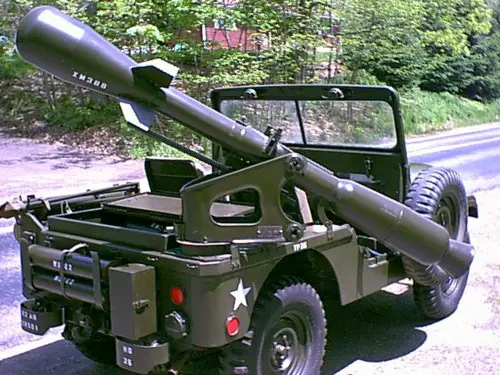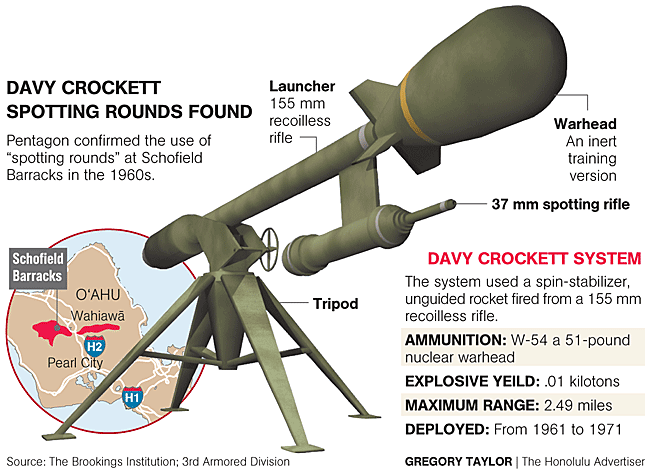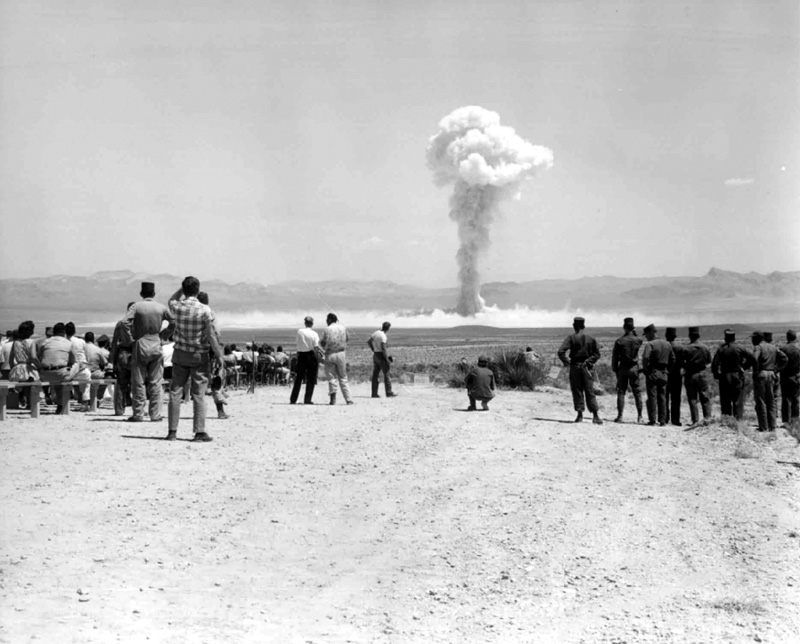
Posted on 07/18/2014 2:02:27 AM PDT by 2ndDivisionVet
The USA fired its last above-ground nuclear test at a test site in Nevada on this day, 17 July, in 1962. The operation was a culmination exercise that brought together nuclear warhead tests (code-named Little Feller, as a nod to the W54 warhead’s light weight and low yield) and nuclear weapons employment maneuvers code-named Ivy Flats.
The test was a pretty-much full-spectrum test of an actual tactical nuke, and a very unusual one — a nuclear infantry weapon called the Davy Crockett. A lot of tripe is written about the Davy Crockett, including that it could not fire a projectile further than its blast radius, but most of that tripe is written by people who either apply unreasoning fear to all nuclear weapons (something that was encouraged during the Cold War by the Soviet Union and its witting and unwitting agents of influence), or by the sort of uninformed juicebox mafiosi that become “national security” writers for Wired. Even more-respected anti-nuclear campaigners often got it wrong, like some of the details on this basically solid page at the Brookings Institution. In fact, this test demonstrated that the weapon was safe, within its limits, and effective.
After many rehearsals, including a live-fire of an actual warhead suspended three feet above the ground (Test Little Feller II on 7 Jul 62), a Davy Crockett crew fired their weapon at a simulated enemy force 2,852 meters distant. They launched the projectile in front of trench-covered friendlies and — much further back — bleachers full of observers, including such VIPs as Robert F. Kennedy (then Attorney General) and Army Chief of Staff Max Taylor. (This test was Little Feller I, even though it was 10 days after Little Feller II). The weapon functioned flawlessly. Within half an hour, military units advanced through the blast zone. The entrenched troops were 1600m from the detonation; the Army calculated that the low-yield W54 would produce immediate casualties from radiation only within 250m, and delayed casualties only within 350m, of its impact point. These radiation effects were much more long-ranged than the heat and blast effects of the .02 kiloton warhead. A tank 100m from detonation would be usable, apart from the effects of radiation, which would have killed its crew.
Here’s a video of the test. We tried to find the original because this one has too much compression and a lot of video artifacts, but sometimes you have to take what you can get:
(VIDEO-AT-LINK)
The actual burst is at about the half-way point, about nine minutes in. Other reports suggest that its yield was later calculated to be 0.018 kt, a little lighter than the 0.022 produced by the confusingly earlier Little Feller I test. As none of the surviving documentation suggests that this yield variation from the nominal 0,02 kt setting upset anyone at the time, it suggests that variance of plus or minus two-thousandths of a kiloton was considered nominal.
It’s interesting to see the other equipment the troops, from the 4th Infantry Division then at Ft. Lewis, Washington, have: Garand M1 rifles, M48 tanks, a Hiller UH-12 helicopter.
The Davy Crockett was actually an ingenious weapon, and for its time, an effective one, if only psychologically. How effective? Decades after it was retired, it was still taught to Soviet tank officers as a battlefield threat to be feared and targeted. When the weapon was withdrawn (due to further miniaturization allowing longer-range and more-accurate delivery of tactical nukes), the GRU managed to convince itself, and the Soviet General Staff, that the withdrawal was all a ruse by those perfidious Americans.
Here’s how it worked: the DC came in two versions, the M28 and M29. The “light” DC had a 2000 meter range, and the heavy 4000 meters. The caliber of the main recoilless gun was different: 120mm versus 155 mm, and even the caliber of the spotting gun, which was used to check trajectory before firing, differed: the “light” Davy Crockett has a 20mm recoilless spotting gun firing the M101 spotting round, and the “heavy” had a 37mm. Because the gun was recoilless, it and its tripod could be light. Both versions could be carried by Jeep or M113 Armored Personnel Carrier, and the M28 could be broken down into manpack loads (if heavy ones) and carried by its own crew.

When XM101 spotting rounds were found in Hawaii, the media went haywire. Typical of the products of their “layers and layers of editors” was this graphic.

What’s wrong with it? Count the legs on the tripod.
The projectile, the M388, was roughly the size and shape of a prize watermelon, and could contain conventional explosives or a W54. It worked with both guns because it was a “supercaliber” projectile. (Imagine a watermelon-sized rifle grenade). A different piston was used in the smaller and larger guns. They also fire two non-nuclear (or simulated nuclear) Davy Crockett rounds.
A war in which battalion commander had their own nukes would have been… interesting. Army planners expected the US warhead stockpile to grow to over 150,000 warheads to support their Pentomic Division warfighting scheme. (That was about five times its actual 1967 peak).
The dummy version was of the M388 the M421. Almost all surviving documentation shows these weapons as non-type-classified, “XM” weapons (i.e. XM388, XM29, etc).

Authority to deploy the Davy Crockett was devolved almost as low as nuclear weapons commit authority ever got: the battalion commander had full authority to use the weapons as he saw fit, once a general release was granted.
Most Davy Crockett launchers were allocated only one or two warheads, plus several conventional high-explosive ones; this was because the system’s survivability on a tactical nuclear battlefield was somewhat constrained. It had to be fired within field-gun and mortar range of the targeted enemy (4,000m max), it was an unprotected weapons system, and it was
The launch produced a considerable backblast, and would have exposed the firers to enemy retaliation. This gave a small advantage to the light weapon, which was usually fired from its jeep. The heavy weapon had to be dismounted from a charmer personnel carrier or truck and fired from the tripod every time. Then, after exposing its position, it would have to be reloaded before the crew could skedaddle.
The Davy Crockett had a short service life; it was an interim weapon before warheads could be miniaturized into standard gun artillery weapons.
Because the M101 spotting rounds contained depleted uranium, which is now managed as a hazardous material, we’ve learned that 75,318 rounds of spotting M101 were produced. Some 2000 were expended in lot qualification tests at the factory, 44,000 were destroyed by firing into a containment after the weapon was scrapped, and a max of 29,000 were fired from the deployed launchers at a variety of field sites. Apart from the Ivy Flats/Little Feller I test on 17 Jul 62, no Davy Crockett was ever live fired. (There were warhead live tests earlier, during development).
Both versions of the Davy Crockett used the same projectile, the M388.
At the end of FY 62, the USA had 25,540 operational warheads in its stockpile, and growing. About 2,900 of them were Davy Crockett warheads. At the end of 2013, we had 4,804 total warheads, and shrinking. Among the entire classes of nukes that were eliminated were small-yield nukes like the Davy Crockett warhead, and battlefield nukes — like the Davy Crockett warhead.
Blew them away....


I am stealing that line.
One DC would have worked magic on Tora Bora, early on...
Great photo!
Davy Crockett got (somewhat incorrectly) tagged with being “suicide weapon”
That was because weapons minimun range was inside the blast radius of its warhead . Another issue was that weapon was
detonated by time fuse - firing crew would have to consult
range chart to estimate time of flight and set fuse accordingly
If there were strong head or cross winds warhead could burst
short of target and catch launch crew in blast
There were 2 warheads - 10 tons (.01 kt)nominal yield
and 20 tons (.02 kt) nominal yield - were not user selectable
In the tests can see the variability - one 22 tons and other 18 tons yield
Radiation effects outranged thermal/blast effects. Lethal
(500 rem) radiation extended out to 350 meters (10 ton)
and 400 meters (20 ton)
Weapons effect calculator -
If have MS EXCEL or WORKS or calculator which does fractional exponents
Y = weapons yield (in tons , ie 1 KT = 1000 tons) divided by 2500
Ranges in meters for lethal damage
Thermal (burn on exposed skin)
Y ^ .41 (3rd degree burn, Y raised to .41 power)
Y ^ .40 (2nd degree burns)
Y ^ .38 (1st degree burns)
Blast (4.7 PSI, enough to collapse most houses)
Y ^.33 (Y to .33 power)
Radiation (500 rem dose)
Y ^.19
Example 20 ton Davy Crockett
Thermal 138 meters 3rd degree
145 meters 2nd degree
159 meters 1st degree
Blast 203 meters 4.7 psi overpressure
Radiation 400 meters 500 rem exposure
My view of this urban myth is that it was mostly a joke. However, the whole concept was a desperate one, in my opinion. The Army was in danger of becoming irrelevant (sound familiar) in the nuclear era. The Air Force and Navy were successfully making that argument and the Army budget was shrinking to the level of the National Park Service. This and "Atomic Annie" were the only technologies that put the Army in the nuclear game. As soon as they developed a warhead that could be fired from a standard 8" howitzer, the Davy Crockett headed for the museums.
Disclaimer: Opinions posted on Free Republic are those of the individual posters and do not necessarily represent the opinion of Free Republic or its management. All materials posted herein are protected by copyright law and the exemption for fair use of copyrighted works.